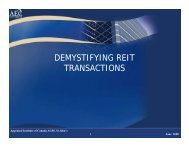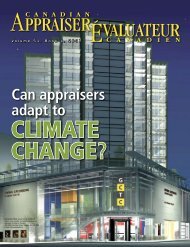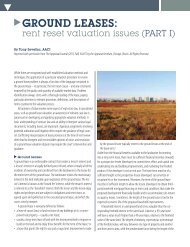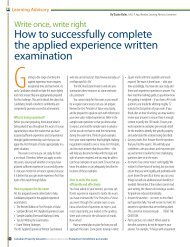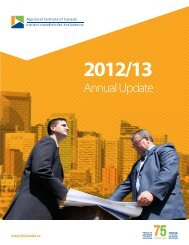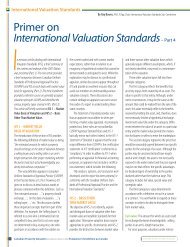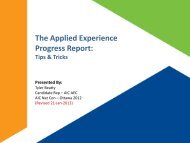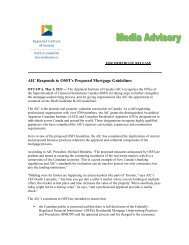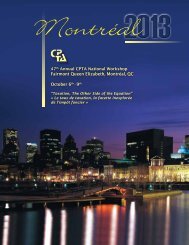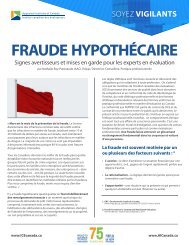Book 4 - Appraisal Institute of Canada
Book 4 - Appraisal Institute of Canada
Book 4 - Appraisal Institute of Canada
You also want an ePaper? Increase the reach of your titles
YUMPU automatically turns print PDFs into web optimized ePapers that Google loves.
InvestigatingSay what you meanand mean what you sayIcannot remember when I first heard thatsaying, but suspect it was from my parentsmany years ago. Then, as a 25-year member <strong>of</strong>the RCMP, I was reminded <strong>of</strong> its importance countlesstimes when conducting investigations and/orgiving evidence. While no longer conducting criminalinvestigations, I find this timeless piece <strong>of</strong> adviceinvaluable in everyday life – and never more evidentthan over the past couple <strong>of</strong> years being an investigatorwith the AIC.My intent is not to speak to the importance <strong>of</strong>good grammar – although we all know this is veryimportant as well – it is to comment on the importance<strong>of</strong> being accurate in what we say, to guardagainst the natural human tendency <strong>of</strong> wanting tomake sense <strong>of</strong> things we see, or to form opinionson limited knowledge or data. People rely on ourreports to be accurate and, if we make statementsthat are later found to be untrue or misrepresent thetruth, our reputation may be devalued – not to mentionour possibly being liable. Think <strong>of</strong> it this way, thewords/phrases you use can have different meanings,i.e., 1) what you mean, 2) what the reader/listenerthinks you mean, and 3) the dictionary definition.In reviewing files, and in everyday life experiences,I find that misunderstandings generally stemfrom two broad areas <strong>of</strong> communication style. Thefirst is making generalized statements without qualifications,i.e., what is ‘old’ and what is ‘young?’ Well,you may be 30 and think 50 is old and 25 is young.What about the 50-year old – he may feel young– and is, compared to his/her parents. What aboutwhen describing the condition <strong>of</strong> someone’s homeor the strength <strong>of</strong> a market? While I am not suggestingthat we cannot use general words/phrases, I amsuggesting that, without qualifying them, you areincreasing the risk <strong>of</strong> being misunderstood.The second communication style that ismisleading to even yourself is making assumptions.Dictionaries define ‘assumption’ as – an act<strong>of</strong> taking to or upon oneself, taking for granted,something taken for granted or accepted as truewithout pro<strong>of</strong>, a supposition, arrogance, etc. It isthis ‘assuming’ that I earlier referred to as a naturalhuman response to our need to try and make sense<strong>of</strong> things we see and hear. At times, this may lead t<strong>of</strong>orming unsubstantiated opinions. However, if wesimply state what we actually know, and not whatwe think we know, we will subject ourselves to lesscriticism due to these possibly misleading and falseassumptions and reduce the risk <strong>of</strong> coming beforethe PPC process. Here are some examples:Is the basement ‘insulated and boarded,’ or isit, ‘boarded and assumed insulated?’ You saw theboarding, but did you see the insulation?Is the property/home ‘owner-occupied,’ or is itactually ‘assumed owner-occupied?’ Do you personallyknow the people that live there, have you seen the title,etc.? Or, could this be the file where the person you metat the property was an imposter stealing mortgagemoney from the real property owner without yourknowledge?When you are shown an environmentally cleancertificate for the subject property, should you say, “theproperty is environmentally clean,” or should you say,“the client provided an environmental clean certificatefor the property” – with further observational commentsas required?Under property history is a statement such as, “Theproperty was purchased by the current owner in March2008 for $500,000” – correct? Or is it, “The clientadvises that he/she purchased the property in March2008 for $500,000?” Or could it be, “Title indicatesthat the property was purchased in March <strong>of</strong> 2008 for$500,000?” If you were not one <strong>of</strong> the parties in thetransaction, how can you be sure the title is correct orthat the client is telling you the truth? How many timeshave clients been untruthful to you?By Gerry Gehlen, AACIMember, Investigating CommitteeThe point <strong>of</strong> the above examples is not to suggestthat you cannot make assumptions, it is to suggestthe importance <strong>of</strong> disclosing those assumptions so thereader/client/user can make better-informed decisions.While we may agree that we do not know the cause<strong>of</strong> why some members/people make more incorrectassumptions than others, I think it is important torecognize that just about everything we do is habit.While my 25 years as a police <strong>of</strong>ficer may have mademe more skeptical than most, it leads me to seequite <strong>of</strong>ten where our members have made incorrectassumptions that lead to misunderstandings. Repeatingor relying on second- or third-hand information asbeing accurate (without verification) is a notoriouslybad habit. Assuming we are doing good work, there isnothing wrong with stating the simple truth – and ifyou do not know something, then say so. No one getsmore credibility on the stand or at the hearing thanthe person who does good work and does not hesitateto admit they do not know everything. It is nevermore evident than in litigation work that it is not goodenough to do good work, you have to be credible.It does not take any longer to develop a good habitthan a bad one – and forming good habits is a habitin itself. If there is one assumption you should make,it is assuming you will eventually have to defend yourwork/statements – so get it right the first time.Investigating CommitteeDarrell Thorvaldson, AACI – ChairMike Schulkowsky, AACIStan Jugovic, AACIGerry Gehlen, AACIPaul Beckwith, AACIJoe Kireta, AACIDeana Halladay, CRATo contact this committee, email:investigating@aicanada.ca38Canadian Property Valuation Volume 54 | book 4 | 2010 Évaluation Immobilière au <strong>Canada</strong>click here to return to table 0f contents



